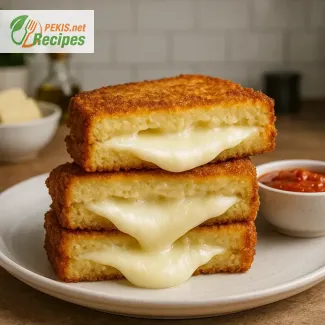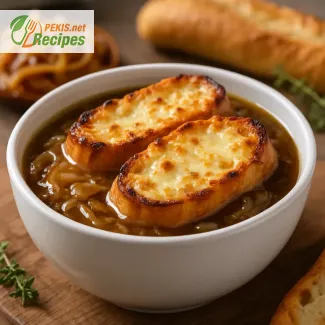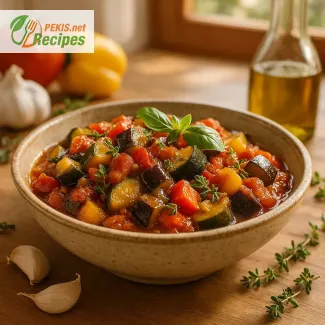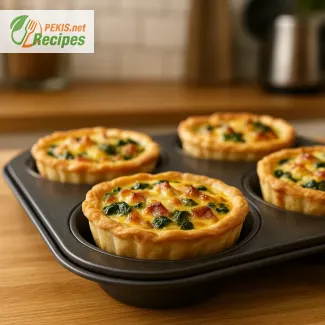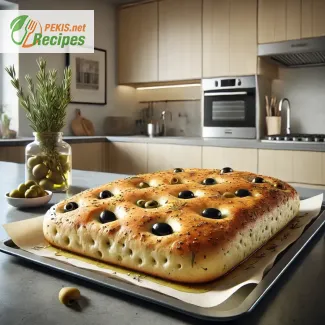
Focaccia with Olives and Rosemary is a beloved Italian bread that captures the essence of Mediterranean cuisine. This soft, yet slightly chewy bread is seasoned with a delicate balance of herbs and olives, bringing a rich, savory taste to every bite. Focaccia is much more than a simple bread; it embodies the traditions, flavors, and warmth of Italian cooking.
Baked to a perfect golden crust with a light crunch on the outside and a soft, airy interior, this bread offers a versatile base for various culinary explorations. Studded with juicy olives and fragrant rosemary, each slice provides an irresistible blend of earthiness and salty sweetness that complements any meal or can stand alone as a delicious snack. The olives, often black or green, contribute their unique Mediterranean character, bringing depth to the bread's profile. Meanwhile, rosemary adds a fragrant, herbal note that heightens the sensory experience, filling your kitchen with its aroma as the bread bakes.
Making focaccia is both a culinary art and a tribute to Italian heritage. Traditional Italian bakers use high-quality ingredients, such as extra-virgin olive oil, which not only enriches the flavor but also creates the bread’s characteristic soft, moist crumb. Olive oil is essential, from drizzling it over the dough before baking to adding subtle depth to the bread’s structure. This luxurious oil also enhances the bread’s appeal, giving it a glossy, inviting appearance when it emerges hot from the oven.
The dimpling technique used in focaccia preparation is more than decorative; it plays a functional role in creating pockets for the olive oil to pool, ensuring a rich, tender crumb. This unique method distinguishes focaccia from other types of bread, creating its signature texture that feels light yet satisfying. The dimples, traditionally made by pressing fingers into the dough, help to evenly distribute the flavors, allowing each bite to deliver the harmonious combination of herbs, olives, and olive oil.
The versatility of focaccia makes it ideal for both casual gatherings and elegant meals. Served as an appetizer with dips or olive oil, or alongside charcuterie and cheeses, it sets the tone for a Mediterranean-inspired meal. It pairs beautifully with a variety of dishes, from grilled meats and roasted vegetables to fresh salads and even pasta dishes. Moreover, focaccia’s hearty texture and robust flavors make it an excellent canvas for creative toppings. Many cooks experiment with different combinations, such as sun-dried tomatoes, garlic, or even chili flakes, each variation offering a new way to enjoy this timeless classic.
Focaccia with olives and rosemary is also a wonderful option for home bakers, as it requires only a few basic ingredients and minimal kneading. For those new to bread-making, focaccia is a gentle introduction to the art, while experienced bakers find satisfaction in perfecting its balance of crust and crumb. Watching the dough rise, scenting the rosemary as it bakes, and finally tasting the warm bread fresh from the oven connects the baker to centuries of Italian tradition and craftsmanship.
In the end, focaccia is more than just bread—it’s a culinary experience that brings people together. Whether shared among friends, enjoyed as part of a family meal, or savored alone with a glass of good wine, focaccia with olives and rosemary transports you to the heart of the Mediterranean. Its flavors reflect the simplicity and beauty of Italian cuisine, where the freshest ingredients come together to create something that is both humble and extraordinary.
- Activate the Yeast: In a large mixing bowl, combine warm water with sugar and sprinkle in the dry yeast. Let it sit for 5-10 minutes until frothy, which indicates the yeast is activated.
- Prepare the Dough: Add olive oil and half of the flour to the yeast mixture, stirring until smooth. Gradually incorporate the rest of the flour and salt until a soft, sticky dough forms.
- Kneading: Knead the dough on a lightly floured surface for about 10 minutes or until it becomes smooth and elastic. Alternatively, knead it in a stand mixer with a dough hook on low speed for about 6-8 minutes.
- First Rise: Place the dough in an oiled bowl, cover with a damp cloth, and allow it to rise in a warm place for 1 hour or until it doubles in size.
- Shaping the Dough: Once risen, punch down the dough to release air. Transfer it to a baking sheet lined with parchment paper and press it into a rectangular shape about 1-2 cm (0.4-0.8 inches) thick. Use your fingers to create dimples across the surface.
- Adding Olives and Rosemary: Gently press the olives and rosemary into the dough, then drizzle with extra olive oil, allowing it to pool in the dimples.
- Second Rise: Cover the dough again and let it rise for an additional 30 minutes.
- Baking: Preheat the oven to 220°C (428°F). Bake for 25-30 minutes, or until the focaccia is golden brown and sounds hollow when tapped on the bottom.
- Serve: Allow to cool slightly on a wire rack, then slice and serve warm. Enjoy as an appetizer, side, or snack.
Enhancing a focaccia recipe like the classic Focaccia with Olives and Rosemary can be an exciting exploration of flavors, textures, and techniques. Here are some professional insights, substitutions, and tips to elevate the quality of your focaccia, each tailored to yield optimal results and help you create the best focaccia that suits your preferences.
1. Choosing the Right Flour
The flour you select is critical in achieving focaccia’s signature light, airy crumb with just the right chew. For the best results:
- Use high-protein bread flour (over all-purpose flour) if possible. The higher gluten content in bread flour contributes to the elasticity and structure of the dough, resulting in a slightly chewier, more resilient focaccia.
- Whole-wheat flour can add a heartier texture and a more complex flavor. If you prefer this option, replace up to 25% of the bread flour with whole-wheat flour to keep the dough airy and light.
- If you want a softer focaccia, substitute a small portion (about 10%) of the flour with potato flour or add a few tablespoons of potato flakes. This trick, often used by Italian bakers, helps retain moisture in the bread, yielding an extra-soft crumb.
2. Perfecting the Hydration
Hydration, or the amount of water in the dough, plays a major role in focaccia’s texture. A well-hydrated dough typically creates a soft, open crumb with large air pockets, which is highly desirable in focaccia.
- Increase water content slightly if you’re aiming for a more airy, open texture. Raising the hydration level by 5-10% (for example, adding 15-30 ml of water) encourages more gluten development, giving you a lighter bread. This technique requires careful handling, as high-hydration doughs are often stickier.
- Incorporate olive oil within the dough rather than just on the surface. This will help bind the dough and add to the flavor, giving you a focaccia that’s both tender and flavorful.
3. Mastering the Olive Oil Component
Olive oil is essential to focaccia, impacting not only the flavor but also the texture of the bread.
- Infuse olive oil with additional herbs and spices such as garlic, chili flakes, or even lemon zest. Let the olive oil sit with these ingredients for at least 30 minutes, then strain it before using. This adds subtle, aromatic undertones to the bread without overpowering the olives and rosemary.
- Generously drizzle olive oil before, during, and after baking. Extra-virgin olive oil is ideal for this purpose due to its robust flavor profile. The more olive oil, the more moist and flavorful the bread will be.
4. Customizing the Toppings
While olives and rosemary are classic toppings, other variations can introduce new layers of flavor and create different focaccia experiences.
- Add caramelized onions or shallots for a touch of sweetness that pairs beautifully with the savory dough.
- Sprinkle coarse sea salt or flaky salt on top. This is a key addition as it contrasts with the soft, airy crumb and enhances the rosemary and olive flavors.
- Experiment with other herbs such as thyme, oregano, or even basil for a unique twist on the traditional focaccia.
5. Techniques for a Superior Texture
Creating the ideal focaccia texture involves several baking techniques that contribute to the bread's overall structure and mouthfeel.
- Use the “stretch and fold” technique instead of traditional kneading, especially if you’re working with a high-hydration dough. By stretching and folding the dough in intervals over 1-2 hours, you allow gluten development without deflating the dough. This method creates an open, airy crumb with larger pockets.
- Dimpling the dough is a signature step for focaccia that impacts both aesthetics and functionality. Press your fingers deep into the dough without tearing it, allowing the dimples to trap olive oil and enhance the flavor. Be gentle yet thorough with this step, ensuring an even distribution of dimples.
- Let the dough rise in the refrigerator overnight (cold fermentation) for a deeper flavor. Cold fermentation slows down yeast activity, allowing the dough to develop complex, slightly tangy flavors.
6. Adjusting for Dietary Needs
Focaccia naturally contains gluten, but for those with dietary restrictions, there are effective ways to adapt this recipe.
- To make a gluten-free focaccia, use a high-quality gluten-free bread flour blend and add a binding agent such as xanthan gum if it’s not already in the flour mix. Gluten-free focaccia may have a slightly denser texture, but you can still achieve a soft, delicious crumb by increasing the hydration slightly.
- For a lower-sodium option, use olives with lower salt content or reduce the salt in the dough. Consider adding a splash of lemon juice or a pinch of garlic powder to bring back some of the flavor lost with reduced salt.
7. Adding Extra Flavor Layers
Elevate the taste by incorporating ingredients that bring out the Mediterranean essence of focaccia.
- Try sprinkling a bit of balsamic vinegar over the dough before baking. This will caramelize slightly in the oven, adding a hint of sweetness and depth to balance the saltiness of the olives.
- Incorporate cheese, such as Parmesan or Pecorino Romano, in the last few minutes of baking. Adding cheese gives the focaccia a savory, nutty finish and complements the herbs beautifully.
8. Ensuring Perfect Baking
Baking focaccia requires attention to temperature and timing to achieve the ideal crust and crumb.
- Use a preheated baking stone or steel if you want an extra-crispy base. Preheating the stone in the oven and then placing the baking sheet on top allows for rapid heat transfer, which creates a well-cooked crust.
- Bake at a slightly lower temperature for a longer time if you prefer a softer focaccia. While the classic recipe suggests 220°C, baking at around 200°C for 35-40 minutes will result in a softer, chewier texture.
9. Finishing Touches
Once baked, focaccia can be enjoyed immediately, but there are a few ways to elevate the presentation and enhance the flavor:
- Brush with additional olive oil after baking while the bread is still hot. This will impart a glossy finish and deepen the olive flavor.
- Sprinkle with fresh herbs like rosemary or parsley just before serving. Adding fresh herbs at the end preserves their bright color and intense aroma.
Health and Nutritional Tips
Focaccia is not only a delicious bread but also provides nutrients that can benefit health when enjoyed in moderation.
- Olives contain heart-healthy monounsaturated fats and polyphenols, which can help reduce inflammation and improve cardiovascular health.
- Rosemary is rich in antioxidants like carnosic acid and carnosol, which protect against cellular damage and support immune function.
- Olive oil used in focaccia is high in Vitamin E and polyphenols that combat oxidative stress, benefiting skin health and cellular repair.
With these tips and techniques, you can personalize your focaccia to suit your taste while achieving bakery-quality results. Focaccia with olives and rosemary can become a true showcase of Mediterranean flavor, with each bite reflecting the care, quality, and simplicity of Italian baking. Whether you enjoy it as is, with dips, or as a side to complement other dishes, this focaccia can be tailored to enhance its flavors and textures, making it a delicious, satisfying centerpiece to any meal.
Gluten: This recipe contains gluten due to the wheat flour.
Tips for Substitution:
- For a gluten-free version, replace the flour with a gluten-free bread flour blend.
- Ensure yeast and other ingredients are certified gluten-free to avoid cross-contamination.
- Vitamin E: Olive oil provides Vitamin E, beneficial for skin and immune health.
- Calcium: Found in olives, supporting bone strength.
- Iron: Present in both olives and rosemary, essential for oxygen transport in the blood.
- Potassium: Contributes to heart health by maintaining proper muscle function.
Polyphenols from Olive Oil:
- Improve cardiovascular health and reduce inflammation.
Flavonoids in Rosemary:
- Act as antioxidants, protecting cells from oxidative stress.


